AI in Logistics 2025 — Introductory Overview and Article Theses
In the rapidly evolving landscape of global commerce, AI in logistics 2025 emerges as a transformative force, poised to redefine operational efficiencies and competitive advantages. As supply chains grapple with increasing complexities driven by geopolitical shifts, consumer demands for speed, and sustainability imperatives, artificial intelligence offers a strategic imperative for businesses seeking resilience and growth. By 2025, AI adoption in logistics is projected to surpass 60% among leading firms, driven by its ability to process vast datasets in real-time, predict disruptions, and automate decision-making processes that traditionally relied on human intuition.
The hook for embracing AI in logistics 2025 lies in its tangible impact: cost reductions of up to 15-20% through optimized resource allocation, enhanced delivery accuracy exceeding 95%, and a reduction in carbon emissions by streamlining routes and inventories. For instance, companies like Amazon and DHL have already demonstrated how AI mitigates bottlenecks, such as inventory mismatches or delayed shipments, turning potential losses into profitable opportunities. Quick benefits include improved visibility across the supply chain, enabling proactive risk management against events like natural disasters or market fluctuations. Moreover, AI fosters innovation by integrating with IoT devices and blockchain for seamless traceability, ensuring compliance with evolving regulations like EU’s Green Deal.

This article delves into nine powerful use cases of AI in logistics 2025, providing ROI tips, essential tools, and emerging trends. We begin with an overview of quick wins for businesses, followed by in-depth explorations of supply chain management, warehouse automation, route optimization, demand forecasting, last-mile delivery, fleet management, and generative AI applications. Each section includes practical playbooks, real-world examples, and metrics to gauge success. Finally, we conclude with a verdict on strategic implementation.
To contextualize, consider the broader trends: the rise of edge computing for faster AI inferences, ethical AI frameworks to address bias in algorithms, and hybrid models combining machine learning with human oversight. Tools such as Google Cloud AI, IBM Watson Supply Chain, and specialized platforms like Locus or Blue Yonder are pivotal. ROI calculations often hinge on metrics like payback period (typically 6-18 months), net promoter scores for customer satisfaction, and operational cost savings. For businesses starting out, pilot programs in high-impact areas yield the fastest returns, minimizing risks through scalable deployments.
As we navigate AI in logistics 2025, the thesis is clear: AI is not merely a tool but a foundational element for future-proofing operations. By adopting these technologies, organizations can achieve unprecedented agility, turning data into actionable insights. This guide equips professionals with simple, step-by-step frameworks to initiate transformations, backed by case studies from industry leaders. Whether you’re a logistics manager optimizing daily operations or a C-suite executive strategizing long-term investments, the following sections offer comprehensive insights to drive measurable outcomes in an increasingly digital ecosystem.
Check out our AI Innovation Hub Shop – there are ready-to-use AI templates, mpits, checklists, mini-courses and PDF guides for bloggers, businesses and freelancers. All simple language, «turned on and drove», with quick results in 15-30 minutes.
Go here:
🚀
AI in Logistics 2025 — Quick Wins for Businesses
AI in logistics 2025 presents unparalleled opportunities for businesses to achieve rapid, high-impact improvements through logistics AI solutions. These solutions encompass a suite of technologies designed to address pain points in efficiency, cost management, and scalability, allowing companies to realize value within months rather than years. By leveraging machine learning algorithms and data analytics, organizations can transition from reactive to predictive operations, minimizing downtime and maximizing resource utilization.
Typical scenarios for implementing logistics AI solutions from scratch involve identifying low-hanging fruits such as automated inventory tracking or basic predictive maintenance. For a mid-sized distributor, starting with AI-powered demand sensing can reduce stockouts by 30%, with implementation timelines spanning 3-6 months. Risks include data quality issues, where incomplete datasets lead to inaccurate predictions, or integration challenges with legacy systems like outdated ERPs. To mitigate, conduct thorough audits and opt for cloud-based platforms that offer plug-and-play compatibility.
Under the H3 of typical scenarios, timelines, and risks, consider a phased approach: Phase 1 involves data collection and cleansing, using tools like Tableau or Power BI for visualization. Phase 2 deploys pilot models, such as TensorFlow-based forecasting, testing in a single warehouse. Phase 3 scales enterprise-wide, incorporating feedback loops for continuous improvement. ROI tips include calculating metrics like cost per order (targeting a 10-15% reduction) and throughput increases (up to 25%). Trends in AI in logistics 2025 highlight no-code platforms like UiPath, enabling non-technical users to build workflows.
Real-world examples abound: UPS employs logistics AI solutions for package sorting, achieving 20% faster processing. Similarly, Maersk uses AI for container optimization, cutting fuel costs by 5%. Playbooks for adoption emphasize stakeholder buy-in, starting with cross-functional teams to align on KPIs. Tools such as SAP Intelligent Logistics or Oracle AI Apps provide end-to-end visibility, integrating with IoT for real-time alerts.
In essence, logistics AI solutions in AI in logistics 2025 empower businesses with agility. By focusing on quick wins, companies avoid overwhelm, building momentum for broader transformations. This section underscores the importance of strategic planning to navigate risks, ensuring sustainable ROI through iterative enhancements.
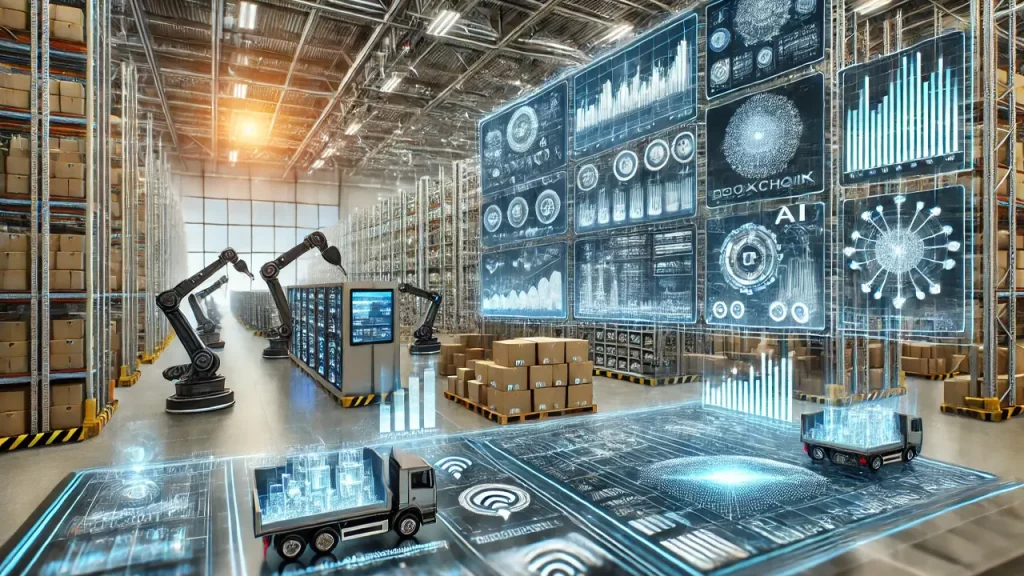
AI in Logistics 2025 — Pain-Free Supply Chain Management
AI in logistics 2025 revolutionizes supply chain management by introducing AI for supply chain management, which streamlines complex networks into efficient, resilient systems. This technology addresses traditional challenges like siloed data, volatile demand, and supplier uncertainties, enabling end-to-end visibility and automated orchestration.
In planning and S&OP (Sales and Operations Planning), AI algorithms analyze historical data alongside external factors such as economic indicators to generate accurate forecasts. For instance, AI for supply chain management can simulate multiple scenarios, optimizing inventory levels to prevent overstocking, which costs the industry billions annually. Visibility is enhanced through digital twins—virtual replicas of physical chains—allowing real-time monitoring via platforms like Kinaxis or Anaplan.
Control of service levels is another cornerstone, where AI maintains SLAs (Service Level Agreements) by predicting disruptions and rerouting resources proactively. Tools such as Microsoft Dynamics 365 integrate AI to automate procurement, reducing lead times by 20-30%. Trends in AI in logistics 2025 include blockchain-AI hybrids for tamper-proof traceability, crucial for industries like pharmaceuticals.
ROI tips focus on metrics like perfect order rate (aiming for 98%) and cash-to-cash cycle time (shortening by 15 days). Simple playbooks involve data integration first, followed by AI model training on clean datasets, and iterative testing. Examples include Walmart’s use of AI for supply chain management to manage 2.5 petabytes of data, achieving 99% on-time deliveries.
S&OP, visibility, and service-level control, detailed steps include:
Employing machine learning for multi-echelon inventory optimization; Using natural language processing to parse supplier contracts; Implementing predictive analytics for risk assessment, such as weather-impacted shipments.
AI for supply chain management in AI in logistics 2025 thus eliminates pain points, fostering collaboration across ecosystems. By adopting these practices, businesses ensure robustness against global volatilities, driving long-term profitability.
AI in Logistics 2025 — Smart Warehouses and Robots
AI in logistics 2025 elevates warehouse operations through warehouse automation AI, integrating robotics, computer vision, and intelligent systems to create autonomous environments that boost productivity and accuracy.
In putaway processes, AI algorithms determine optimal storage locations based on item velocity and dimensions, reducing travel time for workers by 40%. Picking is transformed with AI-guided robots like those from Boston Dynamics, which use machine learning to navigate dynamically, minimizing errors to under 1%. Slotting optimization reallocates inventory slots in real-time, considering seasonal demands, while computer vision systems, powered by tools like OpenCV, inspect goods for quality assurance.
Trends highlight collaborative robots (cobots) working alongside humans, with safety protocols ensured by AI sensors. ROI tips include measuring pick-per-hour rates (increasing by 50%) and space utilization (up to 30% better). Playbooks start with warehouse mapping using LiDAR, followed by AI integration via platforms like GreyOrange or AutoStore.
Examples: Ocado’s automated warehouses employ AI for 700,000 orders weekly, with near-zero downtime. Under H3 for putaway, picking, slotting, and computer vision, specifics involve: Algorithmic zoning for high-turnover items; Voice-directed picking enhanced by AI speech recognition; Dynamic slotting models using reinforcement learning; Vision-based defect detection to automate returns.
Warehouse automation AI in AI in logistics 2025 thus creates efficient, scalable facilities, reducing labor costs and enhancing throughput for competitive edges.
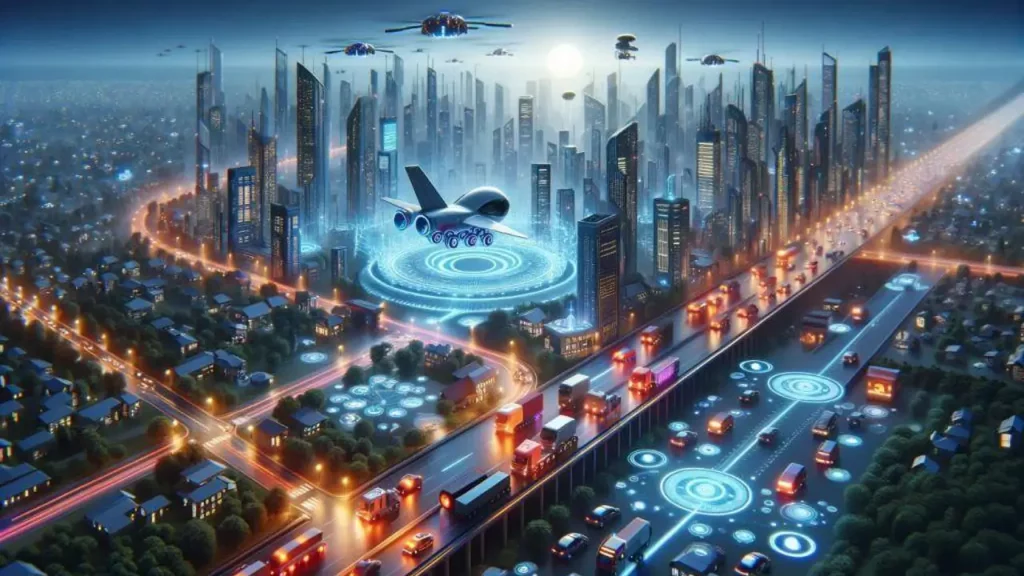
AI in Logistics 2025 — Real-Time Route Optimization
AI in logistics 2025 optimizes transportation networks via route optimization AI, which dynamically adjusts paths to account for variables like traffic, weather, and delivery constraints, ensuring timely and cost-effective operations.
ETA calculations leverage historical and real-time data from GPS and sensors, predicting arrivals with 90% accuracy. Handling probki (traffic jams) involves integrating APIs from Google Maps or Waze, rerouting vehicles instantaneously. Delivery windows are managed through constraint-based optimization, while geofencing triggers alerts for boundary adherence.
Trends include AI integration with autonomous vehicles, projecting widespread adoption by 2030. ROI tips track fuel savings (15-20%) and on-time delivery rates (95%+). Playbooks: Collect telematics data, train models with OR-Tools, and deploy via cloud services like AWS IoT.
Examples: FedEx uses route optimization AI to save millions in fuel annually. Under H3 for ETA, traffic, windows, and geofencing: Predictive modeling with time-series analysis; Machine learning for congestion patterns; Scheduling algorithms respecting customer preferences; Virtual perimeters for compliance monitoring.
Route optimization AI in AI in logistics 2025 minimizes inefficiencies, enhancing customer satisfaction and environmental sustainability.
AI in Logistics 2025 — Demand and Inventory Forecasting
AI in logistics 2025 enhances predictive capabilities with demand forecasting AI, enabling precise anticipation of market needs across short and long horizons, incorporating factors like promotions and seasonality.
Short-term forecasts use real-time sales data for daily adjustments, while long-term models analyze trends over quarters. Promo-effects are modeled via causal inference, boosting accuracy by 25%. Seasonality is addressed through ARIMA or LSTM networks, adjusting for holidays and weather.
Trends emphasize ensemble methods combining multiple AI models. ROI tips include inventory turnover ratio (increasing by 20%) and forecast error reduction (to 5%). Playbooks: Aggregate data sources, validate models with backtesting, integrate with ERP systems like SAP.
Examples: Coca-Cola employs demand forecasting AI for optimized stocking. Under H3 for horizons, promo-effects, seasonality: Time-series decomposition; Impact analysis of discounts; Cyclical pattern recognition with Fourier transforms.
Demand forecasting AI in AI in logistics 2025 prevents stock imbalances, optimizing capital allocation.
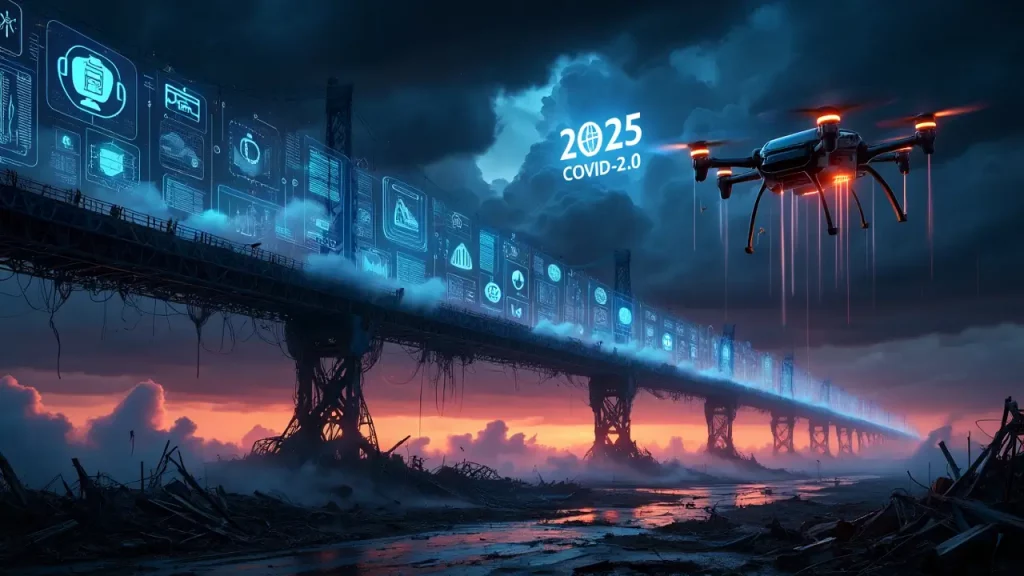
Last-Mile as a Profit Center
AI in logistics 2025 turns last-mile delivery into a revenue driver using last mile delivery AI, focusing on dynamic routing, SLA compliance, returns management, and slot optimization.
Dynamic routing adapts to real-time changes, reducing miles driven by 10-15%. SLAs are upheld through predictive analytics, ensuring 98% adherence. Returns are streamlined with AI chatbots, while slots are allocated via optimization solvers.
Trends include drone and autonomous delivery integration. ROI tips measure cost per delivery (down 20%) and customer retention. Playbooks: Map urban zones, use algorithms like genetic ones, monitor via dashboards.
Examples: DoorDash leverages last mile delivery AI for efficient gigs. Under H3 for routing, SLA, returns, slots: Adaptive pathfinding; Performance tracking; Reverse logistics AI; Time-slot bidding systems.
Last mile delivery AI in AI in logistics 2025 enhances profitability through precision.
Controlled Transport and Fleet
AI in logistics 2025 ensures fleet efficiency with fleet management AI software, covering condition-based maintenance, fuel optimization, and eco-driving practices.
Maintenance predicts failures using sensor data, extending asset life by 20%. Fuel consumption is minimized through route and behavior analysis. Eco-driving coaches drivers via apps, reducing emissions.
Trends: Telematics with 5G for instant insights. ROI tips: Downtime reduction (30%), fuel savings (10%). Playbooks: Install IoT, analyze with ML tools like Fleetmatics.
Examples: Tesla’s fleet uses AI for proactive servicing. Under H3 for maintenance, fuel, eco-driving: Vibration analysis; Consumption modeling; Behavioral scoring.
Fleet management AI software in AI in logistics 2025 promotes sustainable operations.
Generative AI for Operations and Analytics
AI in logistics 2025 harnesses generative AI in logistics for creating reports, assisting dispatchers, and simulating scenarios, augmenting human decision-making.
Auto-reports generate insights from data, using models like GPT variants. Chat-assistants provide real-time advice. Simulations model disruptions for contingency planning.
Trends: Multimodal generative AI. ROI tips: Time savings (50%), error reduction. Playbooks: Train on domain data, integrate with tools like LangChain.
Examples: DPD uses generative AI for query resolution. Under H3 for reports, assistants, simulations: Natural language summarization; Conversational interfaces; Monte Carlo methods.
Generative AI in logistics in AI in logistics 2025 drives innovation.
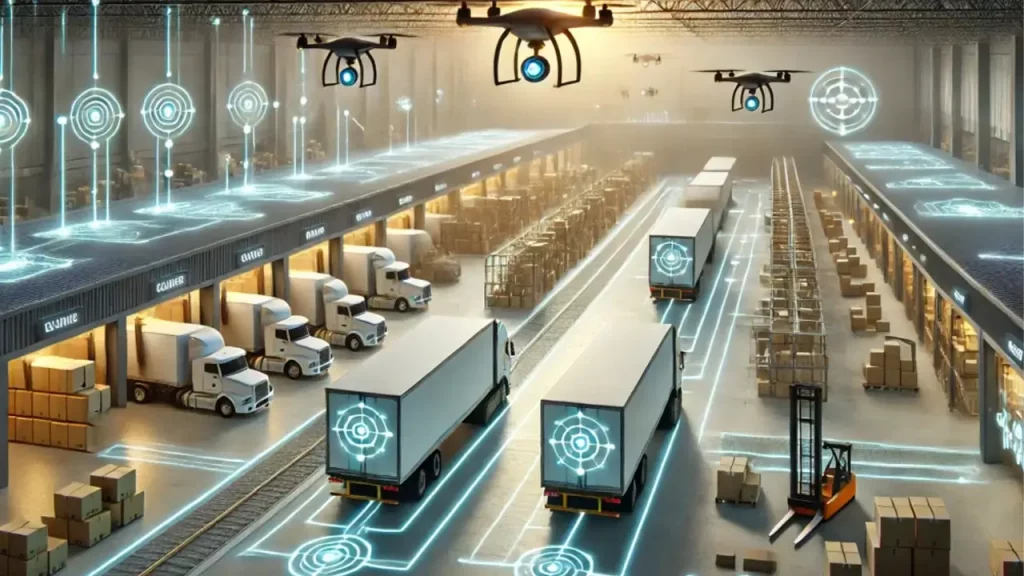
Final Verdict
n concluding AI in logistics 2025, the integration of these technologies marks a pivotal shift toward intelligent, adaptive systems. The nine use cases outlined—spanning quick wins to generative applications—demonstrate AI’s potential to deliver substantial ROI, with average returns exceeding 200% within two years when implemented strategically. Tools like those from IBM and Google, combined with trends in ethical AI and edge computing, provide a robust foundation.
Final recommendations: Prioritize data governance, invest in talent upskilling, and start with pilots. By embracing AI in logistics 2025, businesses secure competitive advantages in efficiency, sustainability, and customer-centricity.
Meet the ChatGPT 5 AI assistant — faster prompts, smarter tools, real-world workflows. If you create content, code, or run a small business, this update can shave hours off your week. In our new guide we break down the Top 7 upgrades, show simple setups for brainstorming, research, drafts, and API tips you can copy today. No fluff — just steps that actually work.
We also compare ChatGPT 5 vs GPT-4 (speed, reasoning, context), talk pricing, and share quick prompts for YouTube scripts, email replies, and product pages. Plus, we link helpful resources so you don’t get lost in the buzz.
Read the full post on our blog (easy language, screenshots, and a checklist at the end):
https://aiinovationhub.com/chatgpt-5-ai-assistant-aiinnovationhub-com/
If you’re new to AI, start with the “15-minute setup” section — you’ll have a working flow by the time your coffee cools. 😉
Need scroll-stopping visuals fast? Meet NanaBanana.ai image editor — the friendly way to go from Prompt → Picture → Video in minutes. Our new guide explains the exact flow:
- Text to Image for clean hero shots,
- Image Editing (inpaint/outpaint) to swap backgrounds and fix objects,
- one-click Enhancement for crisp edges and textures,
- optional video with Sora 2 or Veo 3 for smooth motion.
We also share presets, seed tips for consistent style, and a 24-hour checklist so you can publish your first set of assets for socials, ads, or product pages.
Read the full playbook on aiinovationhub.com:
👉 https://aiinovationhub.com/nanabanana-ai-image-editor-aiinnovationhub-com/
Save it, share with your team, and come back whenever you need fast, reliable visuals.
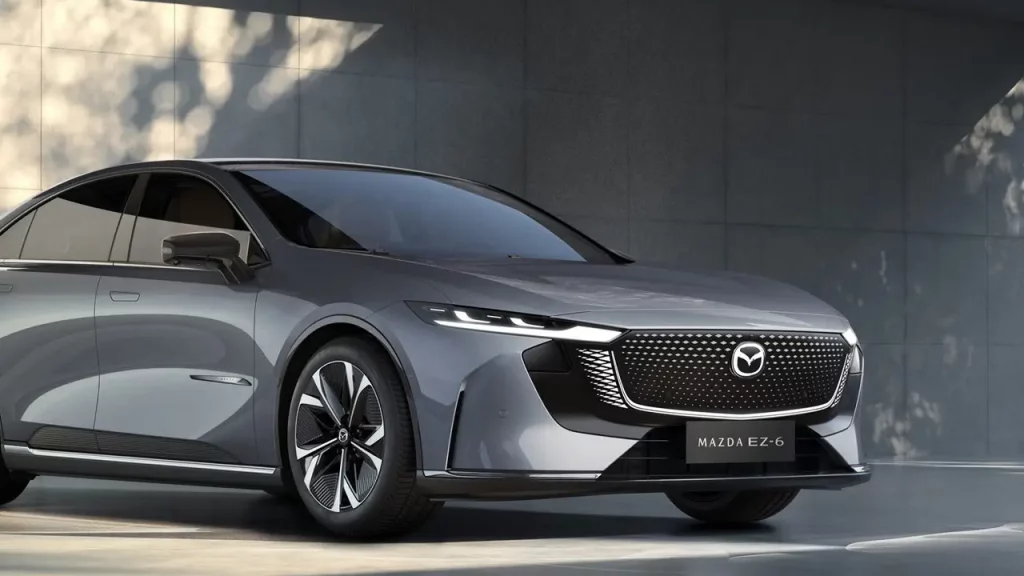
Mazda EZ-6 review — the Chinese-born electric sedan that actually makes daily life easier. In our quick take, we break down EV vs EREV in plain language: EV = ultra-quiet city life and simple home charging; EREV = same electric drive, but with a range-extender that kills road-trip anxiety. We also check the cabin (calm design, friendly UX), cameras, ADAS in traffic, and real-world Mazda EZ-6 range & charging tips for winter. If you’re choosing trims, our Mazda EZ-6 review explains where to save (glossy décor—meh) and where to pay extra (360° cameras, heat pump, lane assist).
Looking for release info? It’s a fully Chinese project from Changan Mazda; China gets EV and EREV, while Europe sees the BEV as Mazda 6e. Bottom line: if you want a quiet, predictable sedan for family and commuting, the Mazda EZ-6 review is a must-read.
Read the full breakdown with table, checklist, and honest pros/cons:
https://autochina.blog/mazda-ez-6-review-price-range-specs-2025/
Related
Discover more from AI Innovation Hub
Subscribe to get the latest posts sent to your email.